170\(^o\)
192\(^o\)
177\(^o\)
182\(^o\)
Correct answer is B
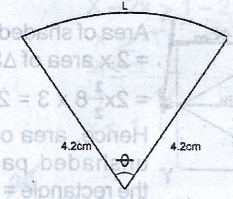
Length of arc, L = 21.4 - 2 x 4.2cm
= 21.4 - 8.4
= 13cm
But L = \(\frac{\theta}{360^o}\) x 2\(\pi r\)
i.e 13 = \(\frac{\theta}{360^o}\) x 2 x \(\frac{22}{7}\) x 4.2
= 13 x 360\(^o\) x 7
= \(\theta\) x 2 x 22 x 4.2
\(\theta\) = \(\frac{13 \times 360^o \times 7}{44 \times 4.2}\)
= \(\approx\) 177.27\(^o\)
\(\approx\) 177\(^o\) (to the nearest degree)

N26,792.00
N26,972.00
N62.792.00
N62,972.00
Correct answer is D
Total donation = 4 x 500 + 7 x 2000 + 20 x 1000 + 9 x 700 + 4 x 500 + 5 x 100 + 3 x 50 + 1 x 2 + 2 x 10 = 20000 + 14000 + 20000 + 6300 + 2000 + 500 + 150 + 2 + 20 = N62,972
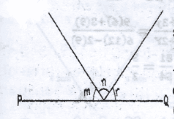
2 : 3 : 4
3 : 4 : 5
4 : 5 : 6
5 : 6 : 7
Correct answer is D
m + n = 110\(^o\), (n + r) = 130\(^o\)
(m + n) = 120\(^o\)
then, r = 130\(^o\) - n
and;
m + (130^o - n) = 120\(^o\)
m - n = -10\(^o\)
2m + (n + r) = 110 + 120 = 230
2m + 130 = 230
2m = 230 - 130
m = \(\frac{100}{2}\) = 50\(^o\)
n = 110\(^o\) - 50\(^o\)
= 60\(^o\)
r = 130\(^o\) - 60\(^o\) = 70\(^o\)
Hence, the ratio m : n : r
= 50 : 60 : 70
= 5 : 6 : 7
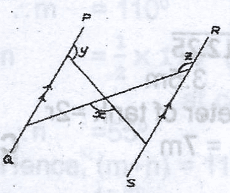
In the diagram, PQ//RS. Find x in terms of y and z
x = 240\(^o\) - y - z
x = 180\(^o\) - y - z
x = 360\(^o\) + y -z
x = 360\(^o\) - y - z
Correct answer is D
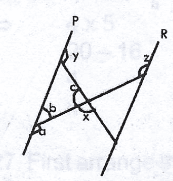
In the diagram,
a = z (alternate angles)
b = 180\(^o\) - a (angles on a straight line)
b = 180\(^o\) - z
c = 180\(^o\) - x (angles on a straight line)
y = b + c (sum of oposite interior angles)
y = 180\(^o\) - z + 180\(^o\) - x
y = 360\(^o\) - z - x
x = 360\(^o\) - y - z
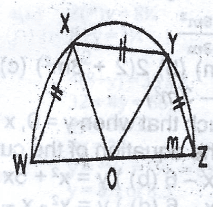
90\(^o\)
60\(^o\)
45\(^o\)
30\(^o\)
Correct answer is B
In the diagram, < WOZ = 180\(^o\) (angle on a straight line)
< WOX = < XOY = < YOZ
(|WX| = |XY| = |YZ|)
\(\frac{180^o}{3}\) = 60\(^o\)
= 60\(^o\)
M + m =2m (base angles of isosceles \(\bigtriangleup\), |OY| and |OZ| are radii)
< YOZ + 2m (base angles of a \(\bigtriangleup\))
60\(^o\) + 2m = 180\(^o\) (sum of a \(\bigtriangleup\))
60\(^o\) + 2m = 180\(^o\)
2m = 180\(^o\) - 60\(^o\)
2m = 120\(^o\)
m = \(\frac{120^o}{2}\)
= 60\(^o\)
WAEC Subjects
Aptitude Tests